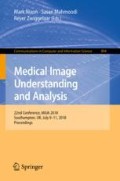Abstract
Deep convolutional neural networks (CNNs) have shown excellent performance in object recognition tasks and dense classification problems such as semantic segmentation. However, training deep neural networks on large and sparse datasets is still challenging and can require large amounts of computation and memory. In this work, we address the task of performing semantic segmentation on large data sets, such as three-dimensional medical images. We propose an adaptive sampling scheme that uses a-posterior error maps, generated throughout training, to focus sampling on difficult regions, resulting in improved learning. Our contribution is threefold: (1) We give a detailed description of the proposed sampling algorithm to speed up and improve learning performance on large images. (2) We propose a deep dual path CNN that captures information at fine and coarse scales, resulting in a network with a large field of view and high resolution outputs. (3) We show that our method is able to attain new state-of-the-art results on the VISCERAL Anatomy benchmark.
Access this chapter
Tax calculation will be finalised at checkout
Purchases are for personal use only
References
Kamnitsas, K., et al.: Efficient multi-scale 3D CNN with fully connected CRF for accurate brain lesion segmentation. Med. Image Anal. 36, 61–78 (2017)
Christ, P.F., et al.: Automatic liver and lesion segmentation in CT using cascaded fully convolutional neural networks and 3D conditional random fields. In: Ourselin, S., Joskowicz, L., Sabuncu, M.R., Unal, G., Wells, W. (eds.) MICCAI 2016. LNCS, vol. 9901, pp. 415–423. Springer, Cham (2016). https://doi.org/10.1007/978-3-319-46723-8_48
Ronneberger, O., Fischer, P., Brox, T.: U-Net: convolutional networks for biomedical image segmentation. In: Navab, N., Hornegger, J., Wells, W.M., Frangi, A.F. (eds.) MICCAI 2015. LNCS, vol. 9351, pp. 234–241. Springer, Cham (2015). https://doi.org/10.1007/978-3-319-24574-4_28
Dou, Q., Chen, H., Jin, Y., Yu, L., Qin, J., Heng, P.-A.: 3D deeply supervised network for automatic liver segmentation from CT volumes. In: Ourselin, S., Joskowicz, L., Sabuncu, M.R., Unal, G., Wells, W. (eds.) MICCAI 2016. LNCS, vol. 9901, pp. 149–157. Springer, Cham (2016). https://doi.org/10.1007/978-3-319-46723-8_18
Bengio, Y., Louradour, J., Collobert, R., Weston, J.: Curriculum learning. In: Proceedings of the 26th Annual International Conference on Machine Learning, pp. 41–48. ACM (2009)
Kumar, M.P., Packer, B., Koller, D.: Self-paced learning for latent variable models. In: Advances in Neural Information Processing Systems, pp. 1189–1197 (2010)
Avramova, V.: Curriculum learning with deep convolutional neural networks. KTH, School of Computer Science and Communication (CSC) (2015). http://kth.diva-portal.org/smash/record.jsf?pid=diva2%3A878140&dswid=3792
Qi, X., Liu, Z., Shi, J., Zhao, H., Jia, J.: Augmented feedback in semantic segmentation under image level supervision. In: Leibe, B., Matas, J., Sebe, N., Welling, M. (eds.) ECCV 2016. LNCS, vol. 9912, pp. 90–105. Springer, Cham (2016). https://doi.org/10.1007/978-3-319-46484-8_6
He, K., Zhang, X., Ren, S., Sun, J.: Deep residual learning for image recognition. In: Proceedings of the IEEE Conference on Computer Vision and Pattern Recognition, pp. 770–778 (2016)
Fidon, L., et al.: Generalised Wasserstein dice score for imbalanced multi-class segmentation using holistic convolutional networks. arXiv preprint arXiv:1707.00478 (2017)
Sudre, C.H., Li, W., Vercauteren, T., Ourselin, S., Cardoso, M.J.: Generalised dice overlap as a deep learning loss function for highly unbalanced segmentations. arXiv preprint arXiv:1707.03237 (2017)
Jimenez-del Toro, O., et al.: Cloud-based evaluation of anatomical structure segmentation and landmark detection algorithms: VISCERAL anatomy benchmarks. IEEE Trans. Med. Imaging 35(11), 2459–2475 (2016)
Glorot, X., Bengio, Y.: Understanding the difficulty of training deep feedforward neural networks. In: Proceedings of the Thirteenth International Conference on Artificial Intelligence and Statistics, pp. 249–256 (2010)
Goyal, P., et al.: Accurate, large minibatch SGD: training ImageNet in 1 hour. arXiv preprint arXiv:1706.02677 (2017)
Nesterov, Y.: Introductory Lectures on Convex Optimization: A Basic Course, vol. 87. Springer, New York (2013)
Wang, C., Smedby, Ö.: Multi-organ segmentation using shape model guided local phase analysis. In: Navab, N., Hornegger, J., Wells, W.M., Frangi, A.F. (eds.) MICCAI 2015. LNCS, vol. 9351, pp. 149–156. Springer, Cham (2015). https://doi.org/10.1007/978-3-319-24574-4_18
Vincent, G., Guillard, G., Bowes, M.: Fully automatic segmentation of the prostate using active appearance models. In: MICCAI Grand Challenge: Prostate MR Image Segmentation, vol. 2012 (2012)
Gass, T., Szekely, G., Goksel, O.: Multi-atlas segmentation and landmark localization in images with large field of view. In: Menze, B., et al. (eds.) MCV 2014. LNCS, vol. 8848, pp. 171–180. Springer, Cham (2014). https://doi.org/10.1007/978-3-319-13972-2_16
Krähenbühl, P., Koltun, V.: Efficient inference in fully connected CRFs with Gaussian edge potentials. In: Advances in Neural Information Processing Systems, pp. 109–117 (2011)
Jiménez del Toro, O.A., Müller, H.: Hierarchic multi–atlas based segmentation for anatomical structures: evaluation in the VISCERAL anatomy benchmarks. In: Menze, B., et al. (eds.) MCV 2014. LNCS, vol. 8848, pp. 189–200. Springer, Cham (2014). https://doi.org/10.1007/978-3-319-13972-2_18
Kéchichian, R., Valette, S., Sdika, M., Desvignes, M.: Automatic 3D multiorgan segmentation via clustering and graph cut using spatial relations and hierarchically-registered atlases. In: Menze, B., et al. (eds.) MCV 2014. LNCS, vol. 8848, pp. 201–209. Springer, Cham (2014). https://doi.org/10.1007/978-3-319-13972-2_19
Acknowledgments
This research was part funded by a NIHR i4i-connect grant.
Author information
Authors and Affiliations
Corresponding author
Editor information
Editors and Affiliations
Rights and permissions
Copyright information
© 2018 Springer Nature Switzerland AG
About this paper
Cite this paper
Berger, L., Eoin, H., Cardoso, M.J., Ourselin, S. (2018). An Adaptive Sampling Scheme to Efficiently Train Fully Convolutional Networks for Semantic Segmentation. In: Nixon, M., Mahmoodi, S., Zwiggelaar, R. (eds) Medical Image Understanding and Analysis. MIUA 2018. Communications in Computer and Information Science, vol 894. Springer, Cham. https://doi.org/10.1007/978-3-319-95921-4_26
Download citation
DOI: https://doi.org/10.1007/978-3-319-95921-4_26
Published:
Publisher Name: Springer, Cham
Print ISBN: 978-3-319-95920-7
Online ISBN: 978-3-319-95921-4
eBook Packages: Computer ScienceComputer Science (R0)

